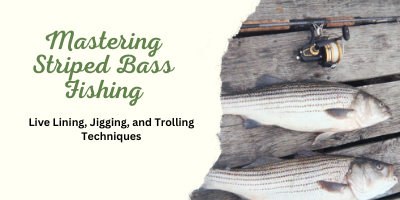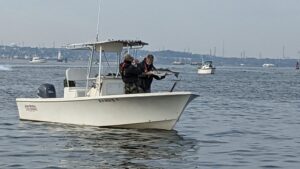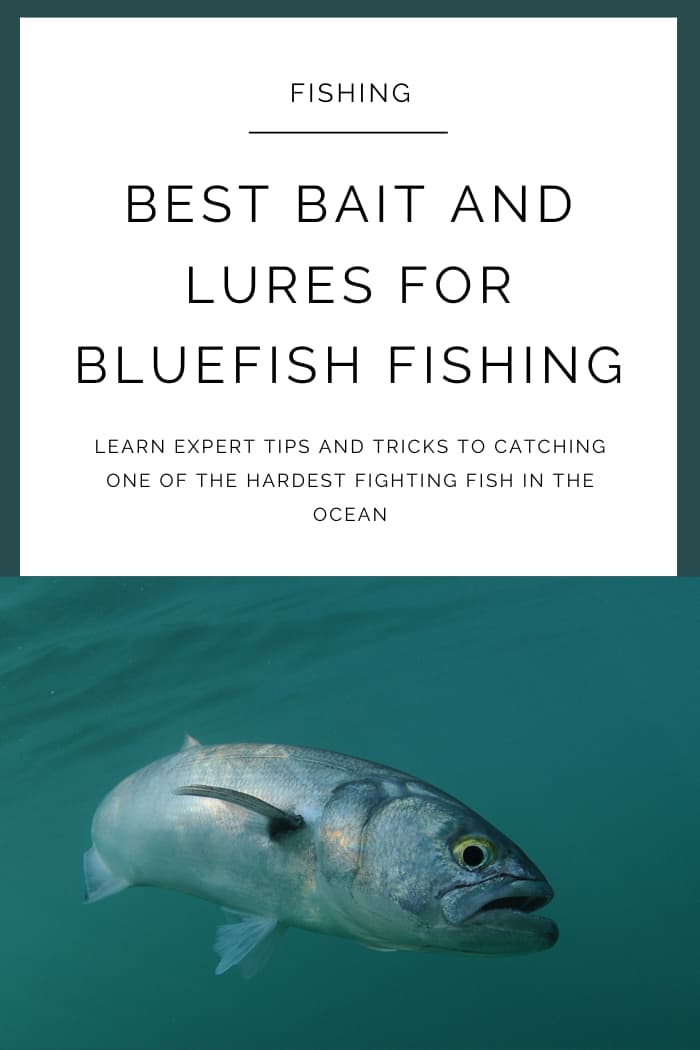Mastering Striped Bass Fishing: Live Lining, Jigging, and Trolling Techniques

Striped bass fishing or stripers are the most sought after game fish in the Mid-Atlantic region. The fish can be found in their seasonal migrations from Maine to The Carolinas. In Central New Jersey, every salty fisherman knows exactly when and where the stripers will be at any given time of year. The best shots at them in our Jersey waters being in the Fall and Spring.
Striped bass, also known as stripers or rockfish, are a prized catch among anglers for their size, strength, and delicious taste. Successfully catching these elusive fish requires a combination of skill, knowledge, and the right equipment. In this comprehensive guide, we will explore three effective techniques for catching striped bass: live lining, jigging, and trolling. To enhance your chances of a successful catch, we’ll also introduce essential gear, including swim shads, flutter spoons, snag hooks, trolling mojos, and trolling striped bass umbrellas.
Live Lining for Striped Bass
One of the main foods for stripers is a large schooling fish called bunker or menhaden. Stripers seek out the schools of these filter feeding fish and ambush them from below. Using a live bunker for bait, what we call live lining, is an extremely effective way to catch a striper.
Live lining is a classic and highly effective method for catching striped bass, especially when targeting larger specimens. This technique involves using live baitfish to entice the striped bass into biting. The key to successful live lining lies in presenting the bait naturally and enticingly.
Catching the bait:
A good throw with a cast net is the best way to catch a good amount of bunker and keep it healthy. A 10ft net with a good amount of weight and larger opening diameter will sink fast and catch the bait most efficiently. This cast net here is a perfect choice.
Another decent option is to use a weighted treble hook cast into a school of bait and quickly reeled back in with a jerking motion. The treble hook snags the bunker allowing you to set it back out as bait. This is not as effective as a cast net because the bait will come back injured and also you will only catch one bait at a time.
-
- When live lining for striped bass, the choice of bait is crucial. Opt for lively and resilient baitfish such as bunker, herring, or mackerel. These baitfish are not only attractive to striped bass but also possess the durability to withstand the predatory strikes.
Rigging your live bait:
-
- Live lining is best done on a conventional setup rod and reel. This combo here is perfect. Use a high-quality fishing line suitable for live lining. A braided main line with a test strength between 20 to 30 pounds offers the strength needed to handle the powerful runs of striped bass. A fluorocarbon leader of about 20 to 30 pounds will provide the stealth necessary to entice wary stripers. Use a large circle hook to hook the bunker through both lips or behind the dorsal fin. You can use a three way swivel to attach a small weight or use no weight at all. Keep the rod in your hands to feel the striper pick up the whole bunker in its mouth, count to three and SET THE HOOK.
Jigging Techniques for Striped Bass
Jigging is a versatile and dynamic method that allows anglers to cover various depths and structures while enticing striped bass to strike. This technique involves vertically working a lure up and down in the water column to mimic the movement of prey.
Swim Shads for Jigging:
-
- An excellent lure choice for jigging is the swim shad. Its lifelike swimming action and realistic profile make it a favorite among anglers targeting striped bass. Choose swim shads in sizes ranging from 4 to 7 inches, depending on the size of the baitfish in the area. Generally you want to cast the shad out as far as you can and steady retrieve it back to you.
Flutter Spoons for Jigging:
-
- Introduce flutter spoons into your jigging arsenal to add a versatile and attractive element to your presentation. Flutter spoons imitate the erratic movement of injured baitfish, enticing striped bass with their flashy and unpredictable action. Rig them with a sturdy treble hook to ensure a solid hookset.
Selecting the Right Fishing Line for Jigging:
-
- For jigging, use a braided line with a lower test strength, typically between 15 to 20 pounds. The reduced diameter of braided lines allows for better sensitivity, enabling you to feel the subtle strikes of striped bass. A fluorocarbon leader of 15 to 20 pounds provides the abrasion resistance needed when fishing around structure.

Trolling Strategies for Striped Bass
Trolling is a method that allows anglers to cover large areas of water efficiently, presenting lures at varying depths and speeds. This technique is particularly effective for locating schools of striped bass that are actively feeding.
Trolling Mojos for Striped Bass:
-
- Trolling mojos are large, heavy lures designed to create a commotion in the water, attracting the attention of striped bass. These lures come in various colors and sizes, mimicking the appearance of large baitfish. Rig trolling mojos with sturdy treble hooks to ensure a solid hookset.
Trolling Striped Bass Umbrellas:
-
- Another effective trolling lure is the striped bass umbrella rig. These rigs consist of multiple swim shads or other lures attached to a single frame, resembling a school of baitfish. Trolling striped bass umbrellas increases the chances of enticing multiple fish at once, leading to more productive fishing sessions.
Choosing the Right Fishing Line for Trolling:
-
- Trolling requires a robust and durable fishing line. Opt for a braided line with a test strength between 30 to 50 pounds, depending on the size of the striped bass in your target area. The increased strength helps handle the stress of trolling, especially when using heavy lures or navigating through structure-rich waters.
Mastering the art of catching striped bass involves a combination of understanding the fish’s behavior and employing effective fishing techniques. Live lining, jigging, and trolling are three proven methods that cater to different preferences and conditions. Equipping yourself with the right gear, including swim shads, flutter spoons, weighted treble hooks, quality fishing line, trolling mojos, and trolling striped bass umbrellas, will significantly enhance your chances of success on the water. So, gear up, head out, and get ready to experience the thrill of landing the striped bass of your dreams.
